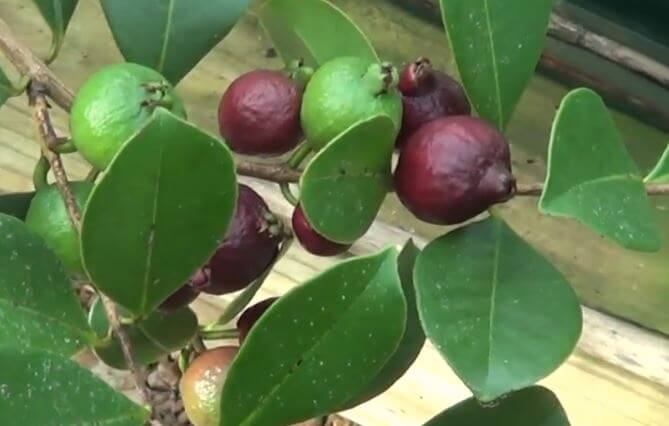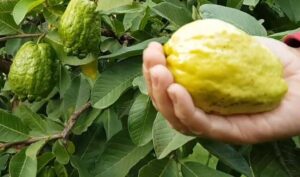In this article, you are going to learn how to grow strawberry guava from seeds.
Overview
Strawberry guava (Psidium cattleianum) is one of the common varieties of guava that is commonly known as cattley guava or red cherry guava in some parts of the tropical and subtropical Americas where it is widely cultivated.
Strawberry guava just like any other guava is a small tree of not more than 20-25 feet in height. The trunk of strawberry guava is usually covered by a grey to brown bark.
The leaves are evergreen and glossy. The fruits have dark red skin from the outside and juicy and fleshy from the inner part of the fruits.
The pulp of strawberry guava fruit is perforated by big lemon-like seeds. The fruits are sweet and have a strong fragrant aroma. The fruits are small and they resemble red cherry.
Cattley guava can grow well in some parts of Florida and California. It can be grown both outdoors and indoors especially in places where is very low temperature.
Strawberry guava usually performs very well under full sunlight and with timely watering. However, the watering is not required much when the tree is fully established on the grounds.
Strawberry guava can withstand a short term drought. However, regular watering is required during fruit production and ripening.
Strawberry Guava Propagation
Cattley guava can be propagated using different methods of propagation. The most common methods of growing guava include grafting, cuttings, budding, layering, and using seeds.
The most common method used for growing strawberry guava is by seeds and this is what we are going to be looking at in this post.
Strawberry Guava Seeds
The seeds of strawberry guava are usually hard and they need to be scarified before planting.
In order to break the dormancy, you need to soak the seeds in boiling water for five minutes. Alternatively, you can also allow the seeds to stay in water for 14 days. All these can help break the dormancy of strawberry guava seeds.
How to Plant Strawberry Guava Seeds
Before you plant strawberry guava seeds, you need the following materials:
- Soiless seed-starting mix
- 4-inch planting mix
Method
To plant the seeds, prepare a potting mix by adding soilless seed-starting mix in a 4-inch planting mix.
Place the seeds on the center of the 4-inch starting mix and gently press them into the center. Add a small handful of the mix to ensure that the seeds are settled in the soilless seed-starting mix. Water slowly to soak the pot. You are also required to be checking from time to time to make sure the soil remains moist.
Germination can take any time from two weeks to eight weeks. After germination, you need to report the seedlings to other containers and grow the seedlings till when they are matured enough to survive on an orchard. You can also grow strawberry guava in a container as a hedge.
Note: place the seeds about 1/4-1/2 down the sterile soil mix and make sure you keep the potting mix moist.
Additionally, make sure the soil is sterile and maintain a temperature as constant as 70-85 degrees Fahrenheit. Know that cool temperatures may significantly lower the germination time and growth rate.
Temperatures below 60-65 degrees Fahrenheit may affect or inhibit the seeds from germinating.
Strawberry Guava Growth Rate
Strawberry guava seeds have a moderate germination rate. Guava seeds in general require enough time to germinate. On average, strawberry guava seeds may require a minimum of 2 to 5 weeks before they start germinating.
Strawberry guava requires warm humid conditions. And if the conditions are favorable, strawberry guava can grow yearly up to 24 inches.
However, this growth rate of strawberry guava solely depends on where the guava plant is initially planted and the climatic conditions of those areas.
Current Facts
Strawberry guava is said to be native to Eastern Brazil. It is presently grown almost everywhere in the tropical regions where it was found to quickly adapt to a wide variety of different climates. However, it was found to be attacked by pests especially in Hawaii and some Caribbean Islands.
Strawberry guava is mostly found growing well on the higher elevation of the tropics. On the other hand, lemon guava or yellow strawberry guava is usually found to grow on the lower elevations with less hardness when compared with Red cherry or strawberry guava.
Strawberry Guava Benefits
The sweet fleshy and juicy pulp of strawberry guava can be eaten fresh or cooked and can also be processed into juices, jams, and desserts.
The fruit is high in folate and other nutrients. And this guava fruit is an excellent source of folic acid to pregnant women.
Both leaves and fruits of guava are a reservoir of nutrients with proven health benefits. You can find more information about the health benefits of guava here.
Strawberry Guava Pictures




Frequently Asked Questions
Can You Eat Strawberry Guava Seeds?
The seeds and pulp of strawberry guava can be eaten together. You can also remove the seeds, grind them into powder, and add into frozen desserts or juices.
Can Guava be Grown from Seeds?
Guava can be grown from a variety of methods and one such ways is growing guava from seeds. However, for commercial purposes, guava is mostly grown from cuttings, grafting, and air layering.
Are Strawberry Guava Good for You?
Strawberry guava is high in vitamin C and low in trans and saturated fats, which make strawberry guava perfect for heart health. Strawberry guava fruit also aids digestion and solve some stomach problems.
How Long does it take for Guava Seeds to Sprout?
Guava seeds can take from 2 to 8 weeks before they germinate. If you want to reduce the time of germination, soak the seeds in a little water for 2 weeks or boil for 5 minutes.
It is important to note that guava plant that is grown from seeds has less vigor compared to the guava plant that is grown from grafting or cuttings.
Conclusion
We hope this guide helps you in understanding how to grow strawberry guava from seeds. We would love to hear your questions and views. So, do write to us in the comment section below.
Recommended reading:
>Nutrition Facts Of Guava And Health Benefits
>Guava Diseases: Distribution, Symptoms, And Management
>Guava Pests: Symptoms And Management
References
Chang, Y.P., Tan, M.P., Lok, W.L. et al. Making Use of Guava Seed (Psidium guajava L): The Effects of Pre-treatments on Its Chemical Composition. Plant Foods Hum Nutr 69, 43–49 (2014). https://doi.org/10.1007/s11130-013-0396-3
Ling CX, Chang YP. Valorizing guava (Psidium guajava L.) seeds through germination-induced carbohydrate changes. J Food Sci Technol. 2017;54(7):2041-2049. doi:10.1007/s13197-017-2641-5 https://www.ncbi.nlm.nih.gov/pmc/articles/PMC5495731/
Chang, Ying Ping & Tan, May & Lok, Wai & Pakianathan, Suganthi & Supramaniam, Yasoga. (2013). Making Use of Guava Seed (Psidium guajava L): The Effects of Pre-treatments on Its Chemical Composition. Qualitas Plantarum Plant Foods for Human Nutrition. 69. 10.1007/s11130-013-0396-3. https://www.researchgate.net/publication/259079103_Making_Use_of_Guava_Seed_Psidium_guajava_L_The_Effects_of_Pre-treatments_on_Its_Chemical_Composition
Salih, Ansam & Alaradi, Haleemah & Ibrahim, Majid & Alhello, Abdulzahra. (2019). EFFECT OF SOME METHODS OF PLANTING IN GUAVA (PSIDIUM GUAJAVA L.) SEED GERMINATION. Plant Archives. 19. 3057-3062. https://www.researchgate.net/publication/337481335_EFFECT_OF_SOME_METHODS_OF_PLANTING_IN_GUAVA_PSIDIUM_GUAJAVA_L_SEED_GERMINATION
“ADVANCES IN GUAVA PROPAGATION” https://www.scielo.br/scielo.php?pid=S0100-29452017000401002&script=sci_arttext




